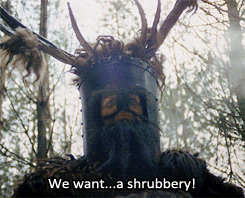Shrubs – What are they and how should you use them?
Shrubs are the kind of plant, where, despite them being almost everywhere, the most experience you have with it is a certain demand by the Knights who say Ni.

But this humble, shorter cousin of the tree can be a really great addition to anyone’s front or back yard. Here are a few interesting facts about the shrub that just might make you consider allowing this awesome little plant into your life:
Different kinds of shrub
Even if you do know of the shrub’s existence, then you can probably only picture the simple little, green bush-like plant. Well, there are actually a lot more variations of the not-bush. The distinction usually comes from the difference in height, the density of foliage (between less than 10 – 100%) and growing environment of the plant in question. Categories for shrubs are usually split into two types; over 2 meters tall, and under 2 meters tall. Categories in the over-two-meters class include: closed scrub (70 – 100%), open shrub (30 – 70%), tall shrubland (10 – 30%) & tall open shrubland (less than 10%). Categories in the under-two-meters class include: closed-heath or closed low shrubland (70 – 100%), open-heath or mid-dense low shrubland (30 – 70%), low shrubland (10 – 30%), low open shrubland (less than 10%). With so many options, there’s sure to be a shrub for you.

There are many kinds of shrubs and growing them together can create a really nice visual effect
Subshrubs
In addition to the different categories, you also have subshrubs. These are subcategories of shrubs, which are usually variations of the plant that ‘hug the ground’. They actually are the kind of thing that people think of when they imagine hedging. Subshrubs include flowers like Lavender, Periwinkle, and Thyme, as well as members of the Heath family of plants like Cranberries and Erica. So, subshrubs are pretty much tiny little shrubs that hug and produce flowers or berries, plus they have the best name in the garden world. What’s not to love?
Shrubs can become trees!
Shrubs are distinguished from trees by the fact that they have multiple stems, and for their generally shorter height. However, depending on their growing conditions and fertiliser, shrubs can get past a certain point of growth, and be classified trees in their own right. If you start to become tired of the shrub-ness of your plant, take good care of it through pruning, and you could turn it into a beautiful, bushy marvel.

A lot of small trees like this were actually once shrubs
Easy to plant, easy to keep
Shrubs are great, and unlike a lot of plants that are great, they require very little upkeep. It’s why they are absolutely everywhere. Shrubs can grow almost anywhere, anytime and in any way. After planting a shrub, add in a good amount of quality soil around the base of the plant. After the root systems have established themselves, the plants should be self-sustaining enough to get moisture for themselves, unless the weather is very dry. After that, just water them every now and then, and you’ll have a healthy shrub.
Shrubs are a great addition to your garden
Shrubs are a very complimentary kind of plant. With their bright, leafy appearance, a good shrub can spice up all manner of garden landscape design. Got a white picket fence? Grow a shrubbery next to it for the ultimate suburban-dream look. Have you decided to tackle the exciting life of hedge trimming and ownership? Put a few subshrubs along it to create a nice contrast to its winding edges. Whatever your current setup, think about how a shrub can add to your home.
Contact us for all types of garden maintenance in Sydney.
